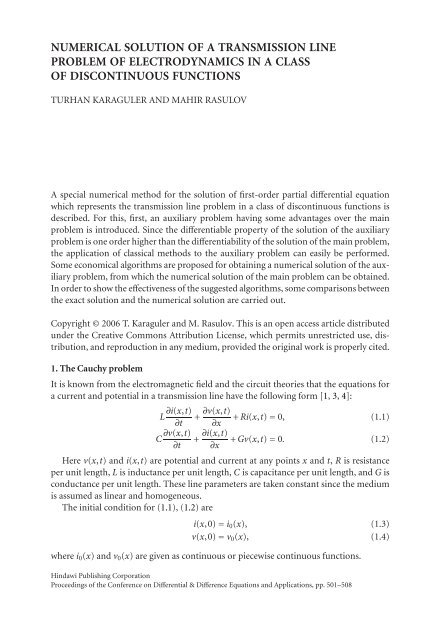DIFFERENtIAl & DIFFERENCE EqUAtIONS ANd APPlICAtIONS
DIFFERENtIAl & DIFFERENCE EqUAtIONS ANd APPlICAtIONS
DIFFERENtIAl & DIFFERENCE EqUAtIONS ANd APPlICAtIONS
Create successful ePaper yourself
Turn your PDF publications into a flip-book with our unique Google optimized e-Paper software.
NUMERICAL SOLUTION OF A TRANSMISSION LINE<br />
PROBLEM OF ELECTRODYNAMICS IN A CLASS<br />
OF DISCONTINUOUS FUNCTIONS<br />
TURHAN KARAGULER AND MAHIR RASULOV<br />
A special numerical method for the solution of first-order partial differential equation<br />
which represents the transmission line problem in a class of discontinuous functions is<br />
described. For this, first, an auxiliary problem having some advantages over the main<br />
problem is introduced. Since the differentiable property of the solution of the auxiliary<br />
problem is one order higher than the differentiability of the solution of the main problem,<br />
the application of classical methods to the auxiliary problem can easily be performed.<br />
Some economical algorithms are proposed for obtaining a numerical solution of the auxiliary<br />
problem, from which the numerical solution of the main problem can be obtained.<br />
In order to show the effectiveness of the suggested algorithms, some comparisons between<br />
the exact solution and the numerical solution are carried out.<br />
Copyright © 2006 T. Karaguler and M. Rasulov. This is an open access article distributed<br />
under the Creative Commons Attribution License, which permits unrestricted use, distribution,<br />
and reproduction in any medium, provided the original work is properly cited.<br />
1. The Cauchy problem<br />
It is known from the electromagnetic field and the circuit theories that the equations for<br />
a current and potential in a transmission line have the following form [1, 3, 4]:<br />
L ∂i(x,t)<br />
∂t<br />
C ∂v(x,t)<br />
∂t<br />
+ ∂v(x,t)<br />
∂x<br />
+ ∂i(x,t)<br />
∂x<br />
+ Ri(x,t) = 0, (1.1)<br />
+ Gv(x,t) = 0. (1.2)<br />
Here v(x,t) andi(x,t) are potential and current at any points x and t, R is resistance<br />
per unit length, L is inductance per unit length, C is capacitance per unit length, and G is<br />
conductance per unit length. These line parameters are taken constant since the medium<br />
is assumed as linear and homogeneous.<br />
The initial condition for (1.1), (1.2)are<br />
i(x,0)= i 0 (x), (1.3)<br />
v(x,0)= v 0 (x), (1.4)<br />
where i 0 (x)andv 0 (x) are given as continuous or piecewise continuous functions.<br />
Hindawi Publishing Corporation<br />
Proceedings of the Conference on Differential & Difference Equations and Applications, pp. 501–508

















